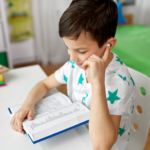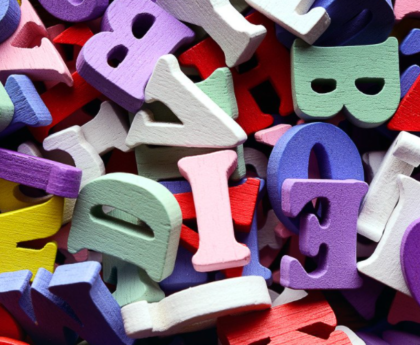When young readers encounter words like”butterfly” or “elephant” for the first time, many freeze in their tracks. These longer, three-syllable words can look like insurmountable mountains to children who have only mastered simple one-syllable words. But with the right approach based on the science of reading and explicit phonics instruction, these seemingly complex words become manageable stepping stones in your child’s reading journey.
For parents and educators working with early readers, understanding how to teach children to decode multisyllabic words is crucial. In this article, we’ll explore how explicit phonics instruction aligns with the science of reading to help children master three-syllable words, along with practical activities and book recommendations to support this important skill.
The Power of Explicit Phonics Instruction for Three-Syllable Words
Explicit phonics instruction means directly teaching the relationship between sounds (phonemes) and letters (graphemes), along with specific strategies for decoding. When it comes to three-syllable words, explicit instruction becomes even more important.
What Makes Explicit Instruction Effective?
- Clear, Direct Teaching: Rather than expecting children to figure out syllable patterns on their own, explicit instruction directly teaches syllable types and division rules.
- Systematic Approach: Instruction follows a logical sequence, building from simple to complex, starting with one-syllable words before progressing to two and three-syllable words.
- Cumulative Learning: New skills build upon previously mastered concepts, creating a strong foundation for tackling increasingly complex words.
- Frequent Practice: Children receive ample opportunities to apply their knowledge with immediate feedback.
Six Key Syllable Types to Teach
Understanding the six syllable types is fundamental to decoding multisyllabic words:
- Closed Syllables: End with a consonant, typically containing a short vowel sound (e.g., in “cab-in,” both “cab-” and “-in” are closed syllables; in “hap-py,” only “hap-” is a closed syllable)
- Open Syllables: End with a vowel, typically containing a long vowel sound (e.g., in “ti-ger,” only “ti-” is an open syllable; in “o-pen,” only “o-” is an open syllable)
- Vowel-Consonant-e Syllables: End with an “e” that makes the previous vowel long (e.g., in “com-pete,” only “-pete” is a vowel-consonant-e syllable)
- R-Controlled Syllables: Contain a vowel followed by “r” (e.g., in “tur-tle,” only “tur-” is an r-controlled syllable; in “gar-den,” only “gar-” is an r-controlled syllable)
- Vowel Team Syllables: Contain two vowels making one sound (e.g., in “rain-bow,” only “rain-” is a vowel team syllable; in “sea-son,” only “sea-” is a vowel team syllable)
- Consonant-le Syllables: End with a consonant followed by “le” (e.g., in “pur-ple,” only “-ple” is a consonant-le syllable; in “tur-tle,” only “-tle” is a consonant-le syllable)
For three-syllable words, combinations of these syllable types form patterns that children can learn to recognize and decode.
Common Three-Syllable Word Patterns
Teaching children to recognize common syllable patterns in three-syllable words makes decoding more manageable. Here are some frequently encountered patterns:
Pattern 1: Closed + Closed + Closed
Examples:
- but-ter-fly
- bas-ket-ball
- pen-cil-case
Pattern 2: Open + Closed + Closed
Examples:
- di-no-saur
- u-ten-sil
- pa-per-clip
Pattern 3: Closed + Open + Closed
Examples:
- el-e-phant
- tel-e-phone
- cat-e-gory
Pattern 4: Closed + Closed + Consonant-le
Examples:
- ar-ti-cle
- obs-ta-cle
- spec-ta-cle
Step-by-Step Approach to Teaching Three-Syllable Words
Based on the science of reading, here’s an explicit, systematic approach to teaching children to decode three-syllable words:
Step 1: Establish a Solid Foundation with One-Syllable Words
Before tackling multisyllabic words, ensure children have mastered decoding one-syllable words of various types (CVC, CVCE, etc.). They should understand basic phonics principles and be able to blend sounds confidently.
Step 2: Introduce the Concept of Syllables
Teach children that syllables are chunks of words containing one vowel sound. Use physical activities to reinforce this concept:
- Clapping syllables in familiar words
- Jumping for each syllable heard
- Tapping the desk for each syllable
Step 3: Teach Syllable Division Patterns
Introduce common syllable division rules:
- VC/CV pattern (divide between two consonants): bas/ket/ball
- V/CV pattern (divide before a single consonant): e/le/phant
- VC/V pattern (divide after a closed syllable): cab/in/et
Step 4: Explicitly Teach Decoding Strategies
- Identify the vowels: Have children circle or highlight all vowels in the word.
- Draw syllable breaks: Teach children to use division rules to mark where syllables begin and end.
- Identify syllable types: Label each syllable according to the six types.
- Decode each syllable: Read each syllable individually.
- Blend syllables together: Combine syllables to read the whole word.
- Adjust if needed: If the word doesn’t sound right, try adjusting vowel sounds (especially with schwa sounds, which often occur in unaccented syllables).
Step 5: Provide Guided Practice with Feedback
Start with carefully selected three-syllable words that follow consistent patterns. As children gain confidence, gradually introduce words with more complex patterns.
Practical Activities for Teaching Three-Syllable Words
Here are engaging, evidence-based activities to help children master three-syllable words:
1. Syllable Sorting
Create cards with common three-syllable words. Have children sort them by syllable patterns (closed-closed-closed, open-closed-closed, etc.) or by the number of consonants between vowels.
2. Syllable Puzzles
Write each syllable of a word on a separate card. Mix up the cards and have children rearrange them to form real words. For example:
- but / ter / fly
- tel / e / phone
3. Color-Coding Syllables
Have children use different colors to mark each syllable in a word. This visual approach helps them see the distinct parts of longer words.
4. Word Building with Manipulatives
Use letter tiles or magnetic letters to build three-syllable words. Children can physically move the letters to form syllables, then combine them to make the complete word.
5. Syllable Hop
Place three hula hoops on the floor, representing the three syllables. Call out a three-syllable word and have children hop into each hoop as they say each syllable.
6. Beat the Clock
Time children as they correctly decode a list of three-syllable words. As their skills improve, they’ll see their times decrease, building confidence in their ability to tackle longer words.
Recommended Books Featuring Three-Syllable Words
Children need exposure to three-syllable words in context. These books naturally incorporate many three-syllable words while telling engaging stories:
Picture Books with Abundant Three-Syllable Words
“The Word Collector” by Peter H. Reynolds
This charming story follows Jerome, who collects words of all kinds, including “two-syllable treats and multisyllable words that sound like songs.” Perfect for introducing the concept of syllables in an engaging way.
“Miss Mary Mack” by Mary Ann Hoberman
Based on the classic hand-clapping rhyme, this rhythmic story about a girl and an elephant helps children feel the beats of syllables naturally.
“Tanka Tanka Skunk!” by Steve Webb
This rhythmic book focuses on the concept of syllables through animal names, making it perfect for teaching syllable awareness.
“Chicka Chicka Boom Boom” by Bill Martin Jr. and John Archambault
While focusing on alphabet learning, this classic also incorporates rhythm and beat in a way that helps children develop syllable awareness.
“A Sick Day for Amos McGee” by Philip C. Stead
This Caldecott Medal-winning book features natural language with many three-syllable words (including animal names like “elephant”) in context.
Decodable Texts for Practicing Three-Syllable Words
While traditional decodable texts often focus on single-syllable words, these resources provide controlled practice with multisyllabic words:
Flyleaf Publishing’s “Reading Series”
Later books in this series introduce multisyllabic words in highly decodable texts.
SPIRE Reading Program
Includes controlled texts with multisyllabic words based on specific syllable patterns.
“From Phonics to Reading” by Wiley Blevins
Includes decodable passages specifically designed to practice multisyllabic words.
Connect Explicit Instruction to Authentic Reading Experiences
While explicit phonics instruction is essential, it’s important to connect these skills to authentic reading experiences. Here’s how to bridge the gap:
- Pre-teach challenging words: Before reading a book together, identify three-syllable words that might be challenging. Practice decoding them using the strategies learned.
- Point out patterns during read-alouds: When reading to your child, occasionally pause at three-syllable words and demonstrate how to break them down.
- Celebrate successful decoding: When your child successfully tackles a challenging three-syllable word during reading, take a moment to acknowledge the accomplishment.
- Connect to writing: Encourage children to use three-syllable words in their own writing, applying their knowledge of syllable patterns.
Why Mastering Three-Syllable Words Matters
Teaching children to decode three-syllable words isn’t just about reading longer words—it’s about building critical skills that support overall reading development:
- Vocabulary expansion: Many important academic and content-area words have three or more syllables.
- Reading fluency: When children no longer stumble over longer words, their reading becomes more fluid and expressive.
- Comprehension improvement: Less mental energy spent on decoding means more focus on understanding.
- Confidence building: Successfully tackling what once seemed like “big, scary words” builds reading confidence that transfers to all texts.
- Independent reading capability: Children equipped with syllable decoding strategies can approach unfamiliar words independently rather than relying on others to help them.
Support Your Child’s Journey with Three-Syllable Words
Remember that learning to decode multisyllabic words is a process that requires patience and consistent practice. Here are some final tips for supporting your child:
- Be explicit but encouraging: Directly teach the strategies while maintaining a positive, can-do attitude.
- Break learning into manageable chunks: Focus on one syllable pattern at a time rather than overwhelming children with too many rules at once.
- Provide plenty of practice: Regular, brief practice sessions are more effective than occasional, lengthy ones.
- Connect to meaningful reading: Always bring skills back to authentic reading experiences to show their real-world application.
- Celebrate progress: Acknowledge improvements in decoding skills, no matter how small.
Take the Next Step with Reading.com
At Reading.com, we understand the importance of explicit, systematic phonics instruction based on the science of reading. Our approach to teaching multisyllabic words is carefully designed to build confidence and competence in young readers.
Our program systematically introduces syllable types and division patterns, ensuring children have the tools they need to tackle increasingly complex words. Through engaging activities and carefully selected texts, we help children apply their phonics knowledge to become fluent, confident readers.
Ready to help your child master three-syllable words and beyond? Download the Reading.com app today for a 7-day free trial and discover how our science-based approach can transform your child’s reading journey.





